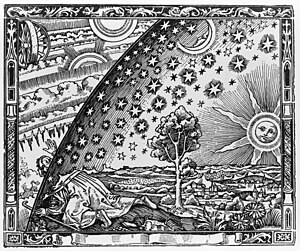Flammarion engraving
The pilgrim kneels down and passes his head, shoulders, right arm, and the top of the walking stick through an opening in the firmament, which is depicted as covered on the inside by the stars, Sun, and Moon.
[1] In 1970, Jung's associate Marie-Louise von Franz reproduced and discussed the image in her book Number and Time, where it was captioned "The hole open to eternity, the spiritual pilgrim discovering another world".
[6] Weber argued that the work was a composite of images characteristic of different historical periods, and that it had been made with a burin, a tool used for wood engraving only since the late 18th century.
In Flammarion's L'atmosphère: météorologie populaire, the image is accompanied by a caption in French, which translates as: A missionary of the Middle Ages tells that he had found the point where the sky and the Earth touch...[2] The illustration refers to the text on the facing page (p. 162), which also clarifies the author's intent in using it as an illustration: Whether the sky be clear or cloudy, it always seems to us to have the shape of an elliptic arch; far from having the form of a circular arch, it always seems flattened and depressed above our heads, and gradually to become farther removed toward the horizon.
These included the Medieval legend of Saint Macarius the Roman, the Letters of François de La Mothe Le Vayer from the 17th century, and the classical argument for the infinitude of space attributed to Archytas of Tarentum (a friend of the philosopher Plato).
This legend includes the story of three monks (Theophilus, Sergius, and Hyginus) who "wished to discover the point where the sky and the earth touch"[10] (in Latin: ubi cœlum terræ se conjungit).
It appears that an anchorite, probably a relative of the Desert Fathers of the East, boasted of having been as far as the end of the world, and of having been obliged to stoop his shoulders, on account of the joining of the sky and the earth in that distant place.
[13]Flammarion also mentioned the same story, in nearly the same words, in his Histoire du Ciel ("History of the Sky"): "I have in my library," interrupted the deputy, "a very curious work: Levayer's letters.
[17]This historian of science Stefano Gattei has argued that the image in the engraving is directly inspired by an argument for the infinitude of space, due to the ancient Greek mathematician Archytas of Tarentum.
Gattei quotes the version of this argument given in the commentary on Aristotle's Physics by Simplicius of Cilicia, written in the 6th century CE: But Archytas, according to Eudemus, put the question in this way: "If I came to be at the edge, for example at the heaven of the fixed stars, could I stretch out my hand or walking stick, or not?
Other books devoted to science that used it as an illustration include The Mathematical Experience (1981) by Philip J. Davis and Reuben Hersh, Matter, Space, and Motion: Theories in Antiquity and Their Sequel (1988) by Richard Sorabji, Paradoxes of Free Will (2002) by Gunther Stent, and Uncentering the Earth: Copernicus and On the Revolutions of the Heavenly Spheres (2006) by William T. Vollmann.
Some books devoted to mysticism which have also used the engraving include Love and Law (2001) by Ernest Holmes and Gnosticism: New Light on the Ancient Tradition of Inner Knowing (2002) by Stephan A. Hoeller.
[20] The Brazilian writer Olavo de Carvalho reproduced the engraving in his 1995 book O Jardim das Aflições ("The Garden of Afflictions"), offering it as an example of Renaissance views concerning the spiritual world, which he criticized: "the pilgrim evades the mundane 'sphere', abandoning trees and flowers, Sun and Moon, birds and stars, to penetrate the marvelous kingdom of the spirit, which consists of some miserable gear wheels hidden among cloud wisps.
"[21] An interpretation of the image was used for the animated sequence about the cosmological vision of Giordano Bruno in the March 9, 2014 premiere of the TV series Cosmos: A Spacetime Odyssey, hosted by the astrophysicist Neil deGrasse Tyson.
In the German-language video series "Von Aristoteles zur Stringtheorie", ("From Aristotle to String Theory"), which is hosted on YouTube and produced by Urknall, Weltall, und das Leben,[22] and features Professor Joseph Gaßner as lecturer, a colored Flammarion engraving was selected as a logo, but the man is peering at a background filled with the important equations of physics.


